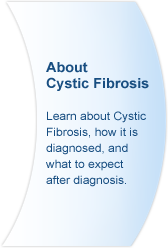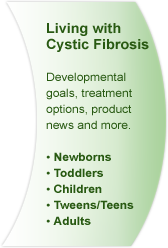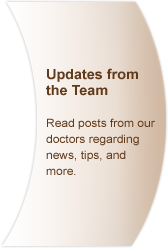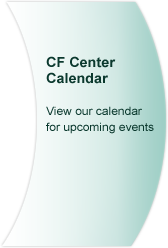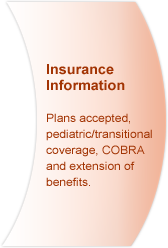|
|||||||
 |
 
TODDLERS (AGES 1-3)Download helpful resources here! 
Latest NewsElectronic Medical Records: We're pleased to announce that Electronic Medical Records (EMR) went live in the Pediatric Center on November 24, 2013. We can now order your medications online, and all the doctors who see a patient within the health system can see important data on the patient, improving the quality of multidisciplinary care. Parenting Children with Cystic Fibrosis CF parents face a unique set of challenges - keeping up with treatments, clinic visits and daily activities can be frustrating, tiresome and isolating. Parenting Children with Health Issues is based on the Love and Logic parenting program developed by child psychologists and parents of children with CF. Click here for more information. Cystic Fibrosis and Constipation in Children: An Underestimated Medical Condition A recent investigation of 214 pediatric CF patients revealed that 47 percent of the CF children studied have constipation. Furthermore, 106 abdominal radiographs were independently assessed utilizing the Barr and Leech scores to determine the test's diagnostic value. The study concluded that constipation is a significant medical issue in CF and was associated with low total fat absorption and a history of meconium ileus; and that abdominal radiography seems of little value in the regular follow-up of CF patients. Source: Constipation in pediatric cystic fibrosis patients: an underestimated medical condition. J Cyst Fibros 2010 Jan; 9(1):59-63. NutritionLike any toddler, those with cystic fibrosis need to eat nutritious meals and healthy snacks. Toddlers with CF also need enzymes, special vitamins and extra calories to gain weight, grow and stay healthy. The CF dietician or care provider will teach you how to meet your toddler's nutritional needs, and you can find more information here.Toddlers are active, curious and want to be in charge - and that includes his or her diet. A toddler will limit the variety of food he or she eats, and will not be receptive to new foods. Also, a toddler's mealtime is shorter than an older child's, and most calories are eaten in the first 10-15 minutes. Most toddlers need 1,000-1,300 calories a day. A toddler with CF may need 30%-50% more calories, or 1,200-1,900 calories daily. Since toddlers with CF will eat the same amount as other toddlers, more calories should be added to their diet. Give the child with CF whole milk to drink at every meal. Serving whole milk dairy products (like cottage cheese, yogurt and pudding) and adding cream on cereal, margarine or butter in everything, and extra cheese on casseroles or pizza puts more calories in the meal for the child with CF. And because toddlers with CF lose more salt when they sweat than toddlers without CF, add more salt to your child's diet and provide salty snacks. As with babies with CF, toddlers with CF may also require tube feedings to gain weight and grow. Nutrition at Daycare If your child is in daycare, plan high-calorie meals and snacks with the daycare center staff. You may have to send extra high-calorie foods if the daycare menu can't be changed. Daycare center staff should also give enzymes before meals and snacks, and report changes in bowel movements. For more about your legal rights on having your child with CF in daycare, see below. Enzymes Your CF care provider or dietician can tell you what kind of, and how many, enzymes your toddler needs. Enzyme dose is based on weight, amount eaten, bowel movements, weight gain and growth. Toddlers don't always want new foods or medicines, including enzymes. As with babies, you will need to break open enzyme capsules and mix the "beads" with a small amount of acidic food, like applesauce, and feed by spoon before meals and snacks. Toddlers who don't want food and medicine mixed can also swallow the plain beads, using a spoon or small medicine cup, before meals and snacks. Enzymes should not be chewed or crushed, and do not put the beads in the food ahead of time for use later in the day. If toddlers refuse enzymes, try giving them some choice and control. Let them open up the capsules and pour the beads into their food, or let them choose the food and mix it with the beads. If your toddler refuses enzymes, let him or her try one or two meals without enzymes and try again. Talk to your CF care provider if your toddler refuses enzymes. Vitamins When fat is not absorbed, fat-soluble vitamins are not absorbed. Your toddler may need a prescription for special multivitamins that have more easily absorbed forms of vitamins A, D, E and K. A liquid multivitamin can be mixed with a small amount of juice or food. High-calorie foods High calorie finger foods include crackers with cheese or peanut butter, soft-cooked vegetables with butter and cheese, pancakes or waffles, and breaded fish or fish sticks. High-calorie spoon-thick foods include applesauce mixed with cream; ice cream; cooked cereal with cream, butter and brown sugar; and mashed potatoes with butter, gravy and sour cream. DaycareIt may be hard for you to find daycare for your child with CF, as some daycare providers may not feel confident in their ability to care for your child. The Americans with Disabilities Act (ADA) may help you if you are having a hard time finding daycare for your child or if you are experiencing discrimination. Under the ADA, a daycare provider cannot refuse to care for a child simply because the child has a disability, unless it is an undue hardship to bring the child into the daycare setting. This is determined on a case-by-case basis. For more on the ADA, click here.Treatment OptionsPostural Drainage and PercussionPostural Drainage and Percussion (PD & P), also known as chest physical therapy, is a widely accepted technique for helping people with CF breathe with less difficulty and stay healthy. PD & P uses gravity and percussion to loosen the thick, sticky mucus in the lungs so it can be removed by coughing. Unclogging the airways is critical to reducing the severity of lung infections. The goal of PD & P is to clear mucus from each of the five lobes of the lungs by draining mucus into the larger airways so it can be coughed out. The right lung is composed of three lobes: upper, middle and lower, while the left lung has two lobes: upper and lower. The lobes are divided into smaller divisions called segments. The left and right upper lobes are made up of three segments each: apical, posterior and anterior. The left upper lobe also includes the lingual, which corresponds to the middle lobe on the right. The lower lobes each include four segments: superior, anterior, lateral basal and posterior basal. Each segment of the lung contains a network of air tubes, air sacs and blood vessels. These sacs allow for the exchange and carbon dioxide between the blood and air. These are the segments that PD & P seeks to drain. Performing PD & P In young children, PD & P must be performed by a caregiver. PD & P involves a combination of techniques including multiple bronchial drainage positions, percussion, vibration, deep breathing and coughing that help move mucus from the lungs to the throat. Once the child is in one of the several prescribed drainage positions, the caregiver performs percussion on the chest wall. Here are the positions for performing PD & P on children and the lung sections that each one targets. Child/Upper Lobes/Apical Segments: The child sits on the flat drainage table and leans backward on a pillow at a 30-degree angle. Stand behind the child and percuss and vibrate over the muscular area between the collarbone and the top of the shoulder blade on both the left and right sides. |
||||||
